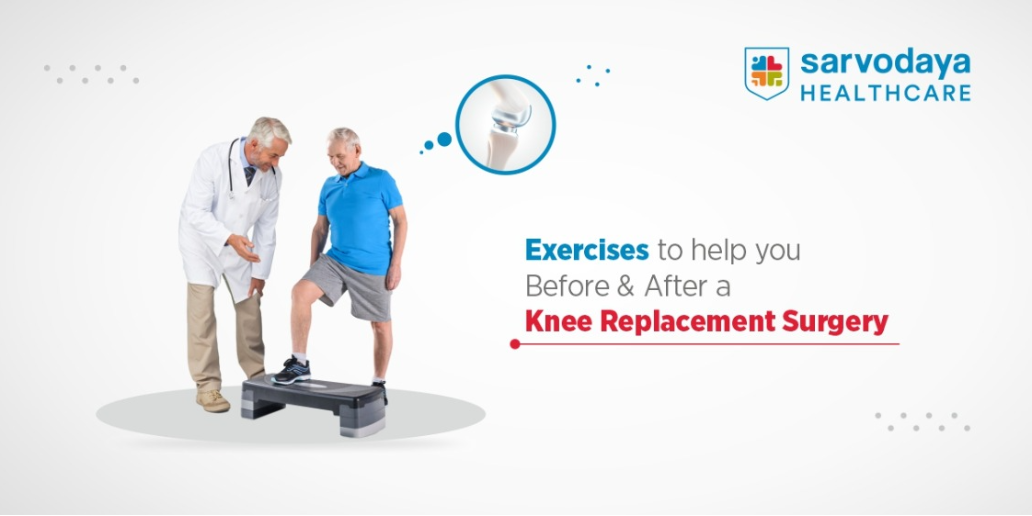Knee replacement surgery has become an exceedingly common treatment method among those patients who suffer from serious knee joint conditions. These conditions may lead to severe bone damage, causing pain & exceeding discomfort. In such cases, knee replacement surgery comes as a boon, especially with advanced techniques in today’s time, including Robotic technology for Joint Replacement Surgery. Such procedures ensure maximum precision & accuracy, which can aid in the swift recovery of a patient. Along with the operation, the overall outcomes are also defined by the patient’s efforts as well. These efforts include one’s adherence to their doctor’s orders, maintaining a balanced diet & most importantly performing basic exercises and undergoing physiotherapy as required, both pre & post the surgery.
Hence, in any patient’s journey, such exercises are frequently required & crucial to the complete recovery of the patient. These can help build mobility & usefulness of the joints post-surgery, as well as aid in building the strength of the joint pre-surgery, to get it prepared for the procedure. Make sure you seek a doctor’s advice before following any routine exercises.
Exercises that can be done pre knee replacement surgery
Knee joint replacement surgery workouts may assist you in developing muscular strength around your knees, which can have a substantial impact on recovery. Some exercises are as follows:
Squeeze your thighs
- Tighten the muscles in your front thighs.
- Hold for 5 seconds before releasing tension.
- Perform up to 3 sets of 5 repetitions.
Straight leg raises (side-lying)
- Lift the upper leg straight up, about 1-2 feet away from the opposite leg.
- Lower your leg and repeat for the other side.
- Perform up to 3 sets of 10 repetitions.
Straight leg raises (regular)
- Lay your foot flat on the floor and bend your healthy knee.
- Straighten your other leg to the height of your healthy knee.
- Hold the position for 2 seconds before slowly lowering.
Clamshell exercise
- Keep your heels together and your knees bent so that they point upwards.
- Like an oyster, open and shut your legs.
Bending the knee
- While sitting, bend your knees as far as they will go.
- Gently return to the regular posture.
Kicks (sitting)
- Raise your leg to a straight position while sitting.
- Gently return to the regular posture.
Kicks (lying)
- Place a rolled-up workout mat, cloth, or cylindrical can beneath your knee.
- Raise your leg to a straight position.
- Slowly come back to the regular posture.
Exercises that can be done post knee replacement surgery
Make sure you undertake exercises only after the suggestions by your doctors. Take extreme precautions while performing such exercises, and do the same under supervision, if required. Post knee replacement surgery, the following exercises may be recommended:
Ankle pumps
- Lie on your back with your legs up straight.
- Position your foot horizontally, then upwards.
Quadriceps exercise
- Push the back of your knee on the floor/bed.
- Tighten the muscles in your front thighs.
- Hold then release your grip.
Exercise the buttocks
- Squeeze your buttocks muscles together to tighten them.
- Hold then release your grip.
Short arc quads
- Raise your leg up to a straight position.
- Slowly return to the original position.
Heel slides
- Pull the heel towards your buttocks and along the floor.
- Perform 2 sets of 10 repetitions daily.
Knee extension (sitting)
- Extend your leg till it is straight.
- Hold for 5 seconds before returning to the regular position.
Exercises & activities to avoid post-knee replacement surgery
Although most activities and exercises may be done safely, following knee replacement surgery, it is best to avoid vigorous activities and exercises that exert undue pressure on your knee implants, like:
- Activities linked with high fall risks Take precautions to keep yourself safe immediately after surgery like using a shower mat with a tight grip, and installing handrails alongside low-height toilet seats.
- Avoid sitting for long periods immediately after surgery This might cause blood clots and swelling in your legs for sitting too long.
- Lifting heavy objects Do not carry big weights or things as this may place too much pressure on your prosthetic knee joint.
- Avoid stairs It is best to avoid stairs until your doctor approves.
- Running and jumping These are high-impact activities that may cause knee joint injury.
- Contact sports Avoid sports that might cause knee injuries due to sudden impact.
Exercises are not a substitute to knee replacement surgery!
Although exercises and home treatments might temporarily ease knee discomfort, knee replacement surgery is required for those whose knees have been seriously injured or damaged. Seek the advice of the best knee replacement surgeons to determine which activities may be beneficial, which exercises to avoid and so on.
Conclusion
At Sarvodaya Hospital, Sec-8. Faridabad, we have a team of the best joint replacement surgeons, who guide the patient through holistic treatment advice, to ensure that one has the best chance at an early recovery. The Centre for Robotic Joint Replacement brings revolutionary and highly advanced robotic technology along with world-class medical facilities with NORTH INDIA’S FIRST FULLY ACTIVE ROBOT (CUVIS) FOR JOINT REPLACEMENT SURGERY to deliver Greater Accuracy – Better Mobility – Faster Recovery for patients suffering from bone and joint disorders. This includes a dedicated regimen, customized to each patient; that can help them build a balance in their health and support their recovery process. This also aids in building mobility and movement in the knee joints. Get in touch to know more today! Call: 1800 313 1414










